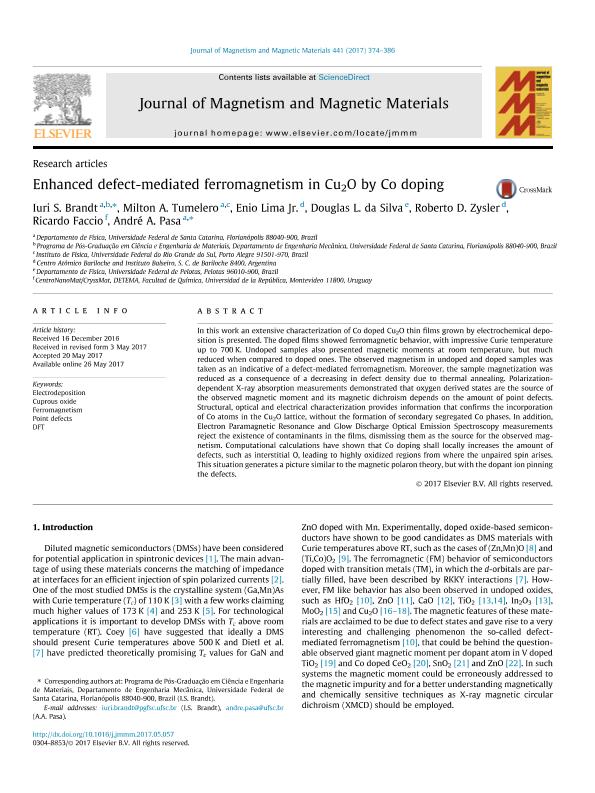Mostrar el registro sencillo del ítem
dc.contributor.author
Brandt, Iuri S.
dc.contributor.author
Tumelero, Milton A.
dc.contributor.author
Lima, Enio Junior

dc.contributor.author
da Silva, Douglas L.
dc.contributor.author
Zysler, Roberto Daniel

dc.contributor.author
Faccio Sgiorovello, Ricardo Juan

dc.contributor.author
Pasa, André A.
dc.date.available
2019-05-02T16:07:16Z
dc.date.issued
2017-11-26
dc.identifier.citation
Brandt, Iuri S.; Tumelero, Milton A.; Lima, Enio Junior; da Silva, Douglas L.; Zysler, Roberto Daniel; et al.; Enhanced defect-mediated ferromagnetism in Cu2O by Co doping; Elsevier Science; Journal of Magnetism and Magnetic Materials; 441; 26-11-2017; 374-386
dc.identifier.issn
0304-8853
dc.identifier.uri
http://hdl.handle.net/11336/75396
dc.description.abstract
In this work an extensive characterization of Co doped Cu2O thin films grown by electrochemical deposition is presented. The doped films showed ferromagnetic behavior, with impressive Curie temperature up to 700 K. Undoped samples also presented magnetic moments at room temperature, but much reduced when compared to doped ones. The observed magnetism in undoped and doped samples was taken as an indicative of a defect-mediated ferromagnetism. Moreover, the sample magnetization was reduced as a consequence of a decreasing in defect density due to thermal annealing. Polarization-dependent X-ray absorption measurements demonstrated that oxygen derived states are the source of the observed magnetic moment and its magnetic dichroism depends on the amount of point defects. Structural, optical and electrical characterization provides information that confirms the incorporation of Co atoms in the Cu2O lattice, without the formation of secondary segregated Co phases. In addition, Electron Paramagnetic Resonance and Glow Discharge Optical Emission Spectroscopy measurements reject the existence of contaminants in the films, dismissing them as the source for the observed magnetism. Computational calculations have shown that Co doping shall locally increases the amount of defects, such as interstitial O, leading to highly oxidized regions from where the unpaired spin arises. This situation generates a picture similar to the magnetic polaron theory, but with the dopant ion pinning the defects.
dc.format
application/pdf
dc.language.iso
eng
dc.publisher
Elsevier Science

dc.rights
info:eu-repo/semantics/openAccess
dc.rights.uri
https://creativecommons.org/licenses/by-nc-sa/2.5/ar/
dc.subject
Cuprous Oxide
dc.subject
Dft
dc.subject
Electrodeposition
dc.subject
Ferromagnetism
dc.subject
Point Defects
dc.subject.classification
Astronomía

dc.subject.classification
Ciencias Físicas

dc.subject.classification
CIENCIAS NATURALES Y EXACTAS

dc.title
Enhanced defect-mediated ferromagnetism in Cu2O by Co doping
dc.type
info:eu-repo/semantics/article
dc.type
info:ar-repo/semantics/artículo
dc.type
info:eu-repo/semantics/publishedVersion
dc.date.updated
2019-04-11T19:51:00Z
dc.journal.volume
441
dc.journal.pagination
374-386
dc.journal.pais
Países Bajos

dc.journal.ciudad
Amsterdam
dc.description.fil
Fil: Brandt, Iuri S.. Universidade Federal de Santa Catarina; Brasil
dc.description.fil
Fil: Tumelero, Milton A.. Universidade Federal de Santa Catarina; Brasil. Universidade Federal do Rio Grande do Sul; Brasil
dc.description.fil
Fil: Lima, Enio Junior. Consejo Nacional de Investigaciones Científicas y Técnicas. Centro Científico Tecnológico Conicet - Patagonia Norte; Argentina. Comisión Nacional de Energía Atómica. Gerencia del Área de Energía Nuclear. Instituto Balseiro; Argentina. Comisión Nacional de Energía Atómica. Centro Atómico Bariloche; Argentina
dc.description.fil
Fil: da Silva, Douglas L.. Universidade Federal de Pelotas; Brasil
dc.description.fil
Fil: Zysler, Roberto Daniel. Consejo Nacional de Investigaciones Científicas y Técnicas. Centro Científico Tecnológico Conicet - Patagonia Norte; Argentina. Comisión Nacional de Energía Atómica. Gerencia del Área de Energía Nuclear. Instituto Balseiro; Argentina. Comisión Nacional de Energía Atómica. Centro Atómico Bariloche; Argentina
dc.description.fil
Fil: Faccio Sgiorovello, Ricardo Juan. Universidad de la República. Facultad de Química; Uruguay
dc.description.fil
Fil: Pasa, André A.. Universidade Federal de Santa Catarina; Brasil
dc.journal.title
Journal of Magnetism and Magnetic Materials

dc.relation.alternativeid
info:eu-repo/semantics/altIdentifier/doi/http://dx.doi.org/10.1016/j.jmmm.2017.05.057
dc.relation.alternativeid
info:eu-repo/semantics/altIdentifier/url/https://www.sciencedirect.com/science/article/pii/S0304885316333741
Archivos asociados
